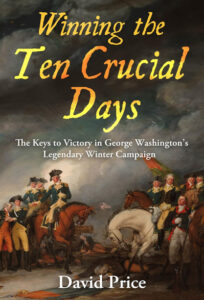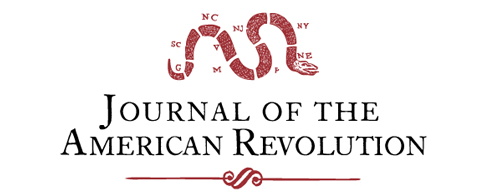BOOK REVIEW: Winning the Ten Crucial Days: The Keys to Victory in George Washington’s Legendary Winter Campaign by David Price (Brookline Books, 2025)
David Price’s Winning the Ten Crucial Days examines Gen. George Washington’s military campaign from December 25, 1776 to January 3, 1777. This short period was one of the most pivotal moments in American history. Washington crossing the Delaware, and the battles of Trenton and Princeton, boosted Patriot morale and demonstrated colonial resilience against the British government. Because of its significance, the campaign has been covered extensively in other works, including David Hackett Fischer’s 2004 Pulitzer Prize winning Washington’s Crossing and William Kidder’s 2019 book Ten Crucial Days. Rather than focus on chronology, David Price takes the thematic route. He outlines five themes: leadership, geography, weather, artillery, and contingency, that led to Patriot victory.
 Price is no stranger to this topic or the Journal of the American Revolution, writing both “Ten Crucial Days, Five Factors,” and “Perspectives on the Ten Crucial Days” for the journal. This is also his third book on the subject, marking Price as one of the leading experts on this historical period. The included appendix quantifies other moving parts within each element. According to Price, this is another way to reinforce to readers each theme’s aggregated effect. It may also be of use to military schools like West Point or The Citadel, who frequently utilize quantitative analysis like this.[1]
Price is no stranger to this topic or the Journal of the American Revolution, writing both “Ten Crucial Days, Five Factors,” and “Perspectives on the Ten Crucial Days” for the journal. This is also his third book on the subject, marking Price as one of the leading experts on this historical period. The included appendix quantifies other moving parts within each element. According to Price, this is another way to reinforce to readers each theme’s aggregated effect. It may also be of use to military schools like West Point or The Citadel, who frequently utilize quantitative analysis like this.[1]
Price’s longest and strongest chapter is on the theme of leadership, particularly that of George Washington. Washington waged a defensive war and “do or die” operations which meant careful planning, and required charisma and theatricality to convince fellow soldiers of his decisions. Price explains that one of Washington’s strengths was to listen to those around him, rather than rely on rigid hierarchy. He could develop a better picture by listening to all points of view.[2] Of course, he also had a sense of presence and confidence that did not go unnoticed. This presence has been noted by other Washington biographers such as Ron Chernow and Joseph Ellis. Price uses primary sources from the rank and file to describe this presence.
The author dedicates a substantial portion of the chapter on leadership to Edward Hand and John Cadwalader, who have “languished in undeserved obscurity.” Notably, Hand’s command utilized any means possible to delay British Gen. Charles Cornwallis from attacking Washington and company at Assunpink Creek, and Cadwalader created a detailed map of British forces. Price’s inclusion of these individuals is refreshing, going beyond Washington’s leadership alone. Price then contrasts American leadership with that of the British. This framework runs throughout each chapter, highlighting the advantages and disadvantages of each theme as it applies to both sides.
The chapter on geography gives some geopolitical context of the conflict. Price states that ruling British officials did not take advantage of Tory loyalties. Many Loyalists were angry with the crown, both for plundering the spoils of war and failing to protect them when Patriots engaged in similar activities. Price could have used primary sources from Loyalist voices to support his argument, perhaps by incorporating works by Maya Jasanoff and Judith Van Buskirk. Ultimately, Price argues that “space and place” was an obstacle the British could not defeat. The sheer size of the colonies, the challenging terrain, and the lack of numbers to defend it cost Britain the war. Conversely, the Patriot side used their spatial awareness of the terrain, and many times the “ground [was] favorable to the rebel cause.” Price gives examples such as the woods along Trenton-Princeton road for cover, the neighboring countryside, and Saw Mill Road cutting past British encampments. While these examples support his argument, Price could have acknowledged that geography wasn’t always favorable to Patriots, like in their struggle maintaining supply lines. What other geographic struggles did Patriots face, and how was this different from this moment in time?[3]
Price’s chapter on weather emphasizes the Delaware crossing. The blizzard made it an arduous journey for the Patriots, but meant a surprise victory at Trenton. On the reverse, the British attempts to advance in Princeton were impeded by temperature changes causing muddy terrain. Much of the chapter reiterates Fischer’s Crossing, and could have reinforced the idea of why Patriots so willingly embraced facing the blizzard. It’s possible that Price did not want to tread on the familiar philosophical ground covered in Fischer’s book. Yet Price’s thematic framework reinforces the idea that the little things add up. What is of note is that Price does not mention hung over Hessians, a myth that may have come from the British excusing their own defeat.
The artillery chapter discusses the importance of Henry Knox, and outgunning the British with the sheer number and increased use of cannon fire. Weather still comes into play here, especially at Trenton when muskets would be rendered useless by the cold. For readers seeking more in-depth analysis on how it involved infantry movements, the chapter is a starting point. Price is focused on the why rather than the how, which has been covered in other works.[4]
Examples of contingency include the capture of Gen. Charles Lee, and General Washington surviving a near-fatal equestrian accident. Luck for these events is tied more to the leadership theme. Washington could be more decisive without Lee in the picture, and survive to make more decisions in the future. Likewise, weather impeded Gen. James Ewing and company from crossing the Delaware, preventing them from being spotted by Hessians. Similarly, Washington’s decision to march his exhausted troops to Morristown meant escaping defeat. The most circumstantial claim is Gen. Stephen’s raid on the Hessians, convincing Rall this was the attack he was warned of. Nevertheless, Winning the Ten Crucial Days may prove Gen. Nathanael Greene right in that “the fate of war is so uncertain, dependent on so many contingencies.”[5]
PLEASE CONSIDER PURCHASING THIS BOOK FROM AMAZON IN HARDCOVER OR KINDLE.
(As an Amazon Associate, JAR earns from qualifying purchases. This helps toward providing our content free of charge.)
[1] David Price, “Ten Crucial Days, Five Factors,” Journal of the American Revolution, September 12, 2023, allthingsliberty.com/2023/03/perspectives-on-the-ten-crucial-days-of-the-revolution/. David Price, “Perspectives on the Ten Crucial Days of the American Revolution, March 2, 2023, allthingsliberty.com/2023/03/perspectives-on-the-ten-crucial-days-of-the-revolution/. David Price, The Road to Assunpink Creek: Liberty’s Desperate Hour and the Ten Crucial Days of the American Revolution (Lawrenceville, NJ: Knox Press, 2019), David Price, Rescuing the Revolution: Unsung Patriot Heroes and the Ten Crucial Days of America’s War for Independence (Lawrenceville, NJ: Knox Press, 2016). “Trenton & Princeton: Winning the Ten Crucial Days (Washington’s Winter Campaign) with David Price,” July 21, 2024, www.youtube.com/watch?v=5G6Q97ItrUA.
[2] David Price, Winning the Ten Crucial Days: The Keys to Victory in George Washington’s Legendary Winter Campaign (Brookline Books, 2025), 9-12.
[3] Ibid., 56-59, 66-73.
[4] Ibid., 91-97.
[5] Ibid., 111, 117-22.





Recent Articles
New Jersey’s Revolutionary Rivalry
The Evolution of the American Declaration of Independence
The Deadliest Seconds of the War
Recent Comments
"The Evolution of the..."
This article is a gem. Sparkling. Excellent research. Wide and deep. Thank...
"The Evolution of the..."
A very interesting article, thank you! A more general question, if you...
"The Evolution of the..."
Thoroughly researched and a succinct presentation, especially given the article's breadth.